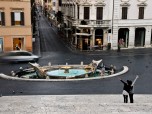The Baths of Caracalla are a ruined complex of public baths in Rome. The building, which dates to the early part of the third century AD, was the second largest bath house in ancient Rome. The baths were largely planned by the emperor Septimius Severus. The entire complex measures more than a thousand feet in each direction and took over half a million bricks to build.
History and Use
Construction of the baths started around 211 AD and completion took nearly six years. They were completed during the reign of Caracalla, after whom they are named. The scale of the project was massive, with 2,000 tons of building materials required on site daily during the construction. The Aqua Maria aqueduct, whose construction was ordered by Caracalla, was designed to bring water to the baths.
Active use of the baths continued for a considerable period after the fall of the Western Roman Empire in 476 AD. Eventually the functionality of the baths came to an end with the turmoil of the Gothic War three quarters of a century later. The Ostrogoths captured the complex, and in the fighting the hydraulic equipment needed to operate the baths was damaged beyond repair. Later, the baths were restored in some fashion, allowing parts of them to be returned to use. Some people claim that bathing took place here until the early 19th century.
Design and Interior
The vast scale of the baths permitted them to be used for a variety of associated purposes. A sizable library existed within the bath precincts, with both Latin and Greek collections. The largest room was the frigidarium, or cold room, which occupied the center of the building and measured 180 by 80 feet. There were also hot and tepid rooms, as well as a swimming pool, plus gymnasiums for boxing and wrestling.
In the past, the Baths of Caracalla featured a number of sculptures, mostly of mythical figures such as Asclepius or heroes of the third century. Many of these statues were more than twice life size, with the Asclepius statue reaching over 12 feet in height. Several of the statues are now on display in Italian museums, including Naples’ Museo di Capodimonte. With the increase in interest in the history and archeology of ancient Rome, considerable attention was paid to the baths from Victorian times onward.
Influence and Modern Use
A number of modern buildings in the western world were inspired by the appearance of Caracalla’s structure. Notable among these are New York City’s Pennsylvania Station and St. George’s Hall in the English city of Liverpool. More recently, the Roman baths were themselves used for the gymnastic events during the 1960 Rome Olympics. Operas are also occasionally held within the complex.





































